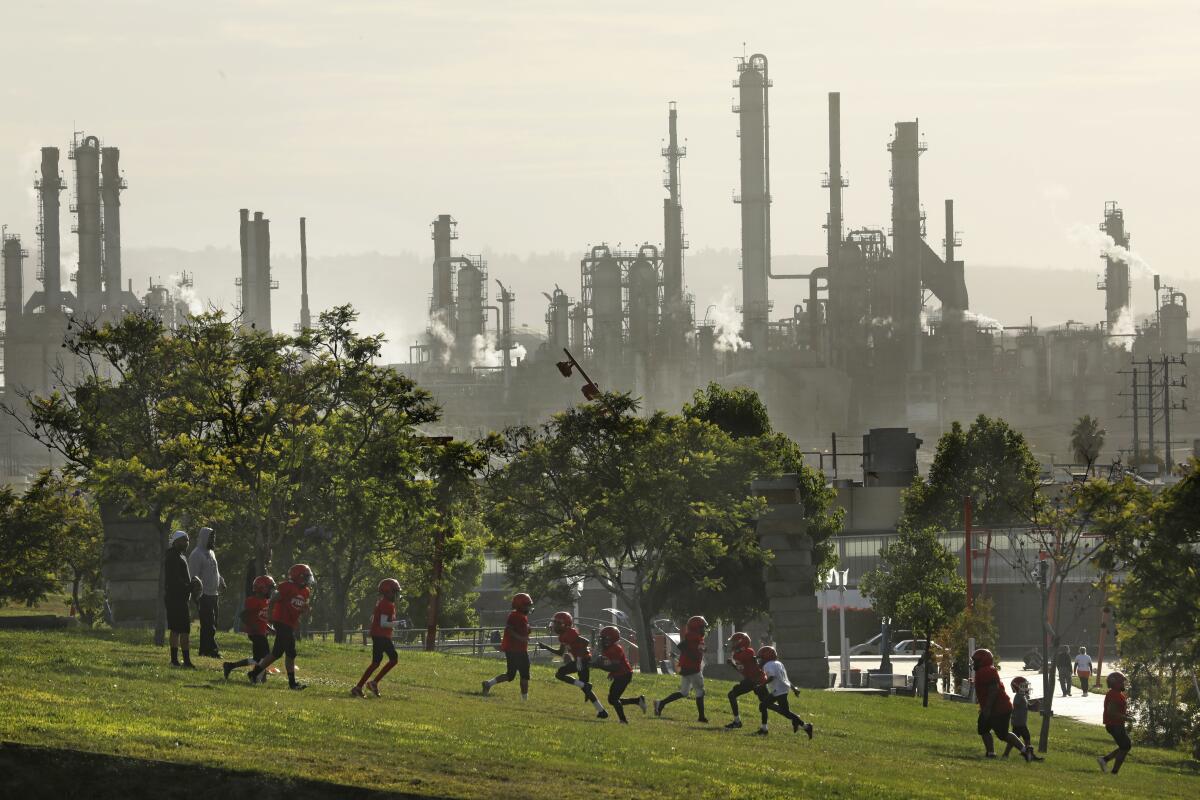Editorial: Regulators let oil refineries avoid cutting smog. They must force them to clean up

- Share via
While the world focuses on the U.N. climate summit in Glasgow, Scotland, here in Southern California air quality officials will be meeting to decide how tough to get on the oil industry and its health-damaging pollution.
The South Coast Air Quality Management District’s governing board is set to vote Friday on new emissions standards for oil refineries, in its biggest proposal to cut smog-forming pollution in years.
The board should adopt the rules and reject any further industry efforts to weaken or delay them.
Southern California must quickly slash pollution to help reverse a troubling trend of worsening smog that is harming the health of millions, especially in communities of color that are hit hardest. Refinery emissions dirty the air from the harbor area to the Inland Empire and regulators have taken too long to get serious about curbing them.
These rules would be the biggest step yet to unwind a regional pollution-trading program that regulators held onto long after it proved ineffectual. They would force the region’s five major oil refineries to upgrade their pollution controls and mark a welcome return to conventional “command and control” regulation, the direct mandates that are behind California’s biggest successes in cleaning its air.
These regulations will, crucially, bring pollution cuts big enough to help shift the tide in the war on smog, which has faltered such that air district officials have acknowledged the region will not meet a 2023 deadline to reduce lung-damaging ozone pollution. Air pollution can damage children’s lungs and trigger asthma attacks, heart attacks and strokes. Regulators’ inability to clean it to federal standards is an ongoing health hazard.
New rules are necessary because of the failure of the Regional Clean Air Incentives Market, or RECLAIM, which the South Coast air district established in 1993 as one of the nation’s first cap-and-trade programs.
The program, which was designed as a more flexible, industry-friendly approach to smog reduction, set a limit on ozone-forming nitrogen oxides and required refineries, power plants and other big polluters to hold enough credits to cover their annual emissions. The credits were tradeable, allowing facilities to buy and sell credits on an open market.
After initial success in reducing emissions, the program grew ineffective, and over time failed to achieve its promised pollution reductions. An oversupply of credits made it cheaper for refineries, in particular, to buy up rights to pollute than to install readily available controls. Oil companies saved money avoiding modern pollution controls, but it came at the expense of public health.
The fossil fuel industry has successfully fought to hold onto the program, even as its shortcomings faced increased scrutiny and came under attack from state regulators and lawmakers. In 2015, the AQMD board brazenly rejected its own staff recommendation to overhaul the program in favor of a weaker plan put forth by the oil industry.
Finally, four years ago the AQMD board voted to dismantle the market-based program and on Friday they’ll consider the most important round of regulations that will establish emissions limits on hundreds of types of equipment and require refineries to install up-to-date pollution controls.
The 13-member South Coast air board, made up of elected and appointed officials from across Los Angeles, Orange, Riverside and San Bernardino counties, has a history of caving to oil interests, sometimes latching onto industry claims that cleaning their emissions will cost jobs.
That just isn’t the case with these rules. The district’s own analysis projects the measures will require such extensive upgrades that they will actually create thousands of jobs in the coming years. It turns out that installing billions of dollars’ worth of new pollution control equipment is a lot of work, and will provide years of increased job opportunities for refinery and construction workers.
Most importantly, new standards will bring significant health benefits, including the prevention of hundreds of early deaths from air pollution and thousands of asthma attacks and lost work days. Those gains will be concentrated in communities such as Carson, west Long Beach and Wilmington that are in the shadow of the region’s refineries. Residents there are in desperate need of more protections, including additional regulations to reduce toxic pollutants from refineries and other industrial operations. Adopting strong refinery rules this week will put help put them on the right path.
Whether in Glasgow or in Southern California, the way forward is clear. For the sake of the planet and the health of local communities, we need much more stringent and direct regulation of oil industry pollution until we phase out fossil fuels entirely.
More to Read
A cure for the common opinion
Get thought-provoking perspectives with our weekly newsletter.
You may occasionally receive promotional content from the Los Angeles Times.










